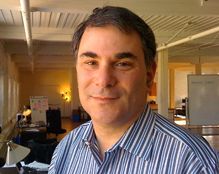In the coming months, our government is going to throw a lot of money at some very big problems. The amount is staggering—a $787 billion stimulus packagecombined with a proposed $3.6 trillion federal budget. That kind of market-making money should be able to drive the bold changes we need in health care andeducation.
I fear it will not.
It would be a shame if the nation’s palpable hunger for fresh ideas and approaches resulted only in incremental change. The problem I see is that most of the money is about to travel through existing pipes to sustain the way the health-care and education industries currently operate. This path simply maintains the status quo.
If we want bold change, we have to allocate more of the federal investment to the design and testing of new approaches that are not constrained by existing ones.
 Education and Workforce Development
Education and Workforce Development
A report last year from the nonprofit network America’s Promise Alliance showed that 1.2 million students drop out of high school each year. Only about half of the students served by school systems in the nation’s 50 largest cities graduate from high school. The U.S. public education system, especially in the country’s urban centers, must be transformed.
Only about 40% of the U.S. adult population earns a college degree. That may have been fine in the 20th century when an industrial economy supplied good jobs to those without post-secondary education. It is not fine today when a college degree is a necessity for a good job.
Our education and workforce development system was built for the 20th century. Stimulus money spent solely to support the current system will not result in a population of life-long learners prepared for the new economy.
An example of how to channel resources toward bold change is the Labor Dept.’s WIRED (Workforce Innovation in Regional Economic Development) program. Launched in 2005 to catalyze the creation of a new 21st century workforce development system, WIRED has made three rounds of grants to 39 regions. Each grant recipient gets $5 million per year over a three-year period. The funds must be used to integrate a region’s economic and workforce development activities. WIRED funds are targeted to accelerate state agency coordination and system change in order to demonstrate that talent development can drive economic transformation in regions across the country.
WIRED is the right idea, but it doesn’t go far enough. There is not enough money allocated to it, and it is not bold enough in holding regions accountable for experimenting with truly transformative workforce development approaches.
Health Care
The first baby boomer turns 65 in 2011. By 2030 there will be 71.5 million Americans over the age of 65, vs. 36 million today. Our health-care system struggles to deliver quality care today at an affordable price. Imagine the implications of the coming silver tsunami, when 10 million to 12 million elders will need long-term care—and an estimated 5 million will need nursing-home care.
The current federal prescription calls for a big investment in electronic health records and making insurance options available to all. Ensuring access and increasing efficiency in today’s system is necessary but not sufficient.
We need bolder solutions to deal with the impending crisis. We need to transform from a sick-care system to a well-care system, with the patient at the center. Patients must become more responsible for their personal wellness and sick-care choices. Too much of the stimulus money is allocated to institutionally driven electronic health records, which will only increase the efficiency of today’s health-care system. A meaningful share (20%) of the funds should go toward electronic records controlled by the patient and to experimenting with patient-centered health-care approaches.
Unconstrained Experimentation
Every federal agency must be held accountable for channeling resources toward transformative and systemic change in its respective area. That should be the focus of Aneesh Chopra, America’s new chief technology officer, or Sonal Shah, head of the new Office of Social Innovation & Civic Participation. They should be armed with resources moved from agency budgets and tasked with driving bold change to build a national innovation agenda. While we balance the management of today’s systems, it’s imperative that we also experiment with new configurations that are not constrained by existing ones. It’s not easy, but all of the public and private sector levers and capabilities should be up for analysis—and reform—in order to enable these experiments.
I used to think you could catalyze innovation by proselytizing. You can’t. It is more important to network today’s innovators from every imaginable silo, sector, and discipline in purposeful ways. It is the innovator’s day. This is the time to experiment with bold new solutions. We must invest in the capacity to explore and test systems-level innovation. Our future depends on it.









Leave a Reply